(Originally posted 29 March 2016 – updated 24 February 2019)
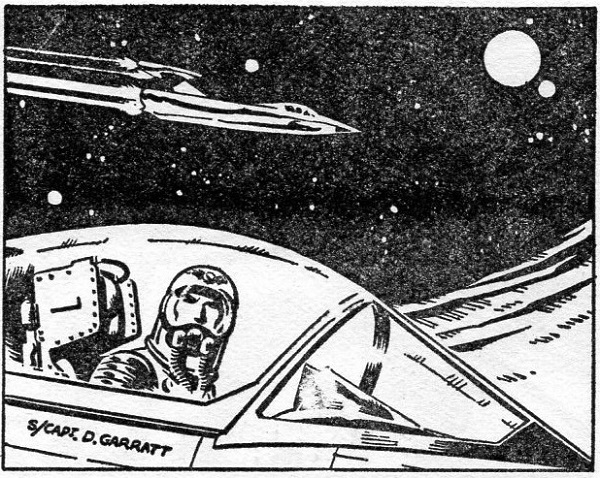
There is a little known science fiction comics character called Dave Garratt who appeared in at least three of the Collins Boys’ Annuals published by William Collins Sons And Co Ltd (now part of HarperCollins) on the cusp of the 1960s. All three strips are by the same artist, Ian Kennedy, signing at that time as Chas Ian Kennedy, who would go on to be the most respected artist illustrating Dan Dare in the 1980s version of Eagle comic.
The three known strips, the 4 page Dave Garratt and the Space Pirates, the 3 page Dave Garratt: Champion Of Peace, and the 3 page Dave Garratt: Space Fighter, are all black and white and produced in a nursery-style format (although they are not nursery content) of single panel images with text below them.
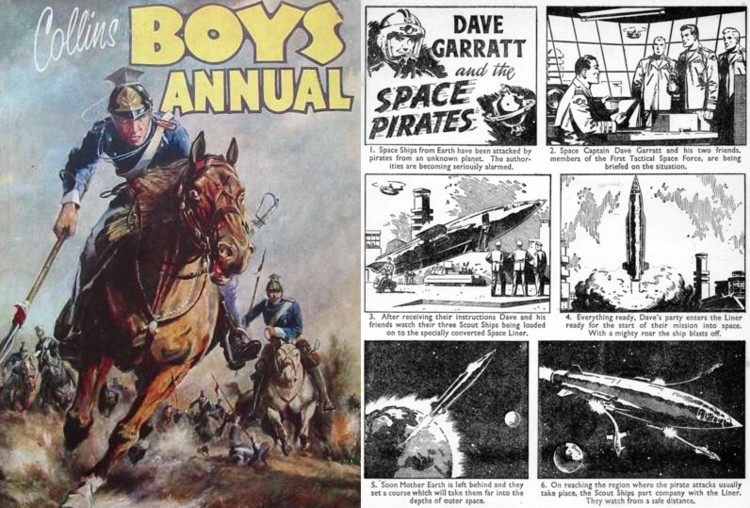
In Dave Garratt and the Space Pirates, space liners are being raided by pirates and Garratt and his colleagues use small scout ships to follow the pirates to their space station where Garratt enters the station, plants explosives and, once back to the safety of his ship, destroys the pirate base.
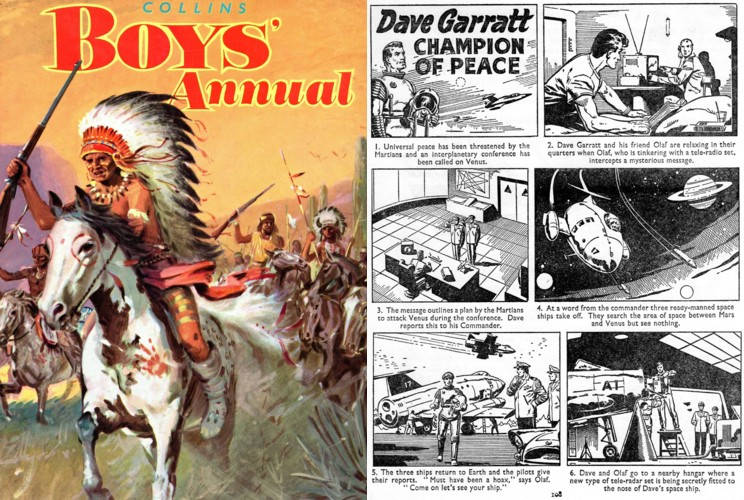
In Dave Garratt: Champion Of Peace when the interplanetary conference on universal peace on Venus is threatened by the Martians, Garratt and his colleague Olaf use their ships’ new tele-radar sets to find the Martian ships, despite them having invisibility cloaks, and are able to alert the Space Force who destroy the Martian fleet before it can attack the conference.
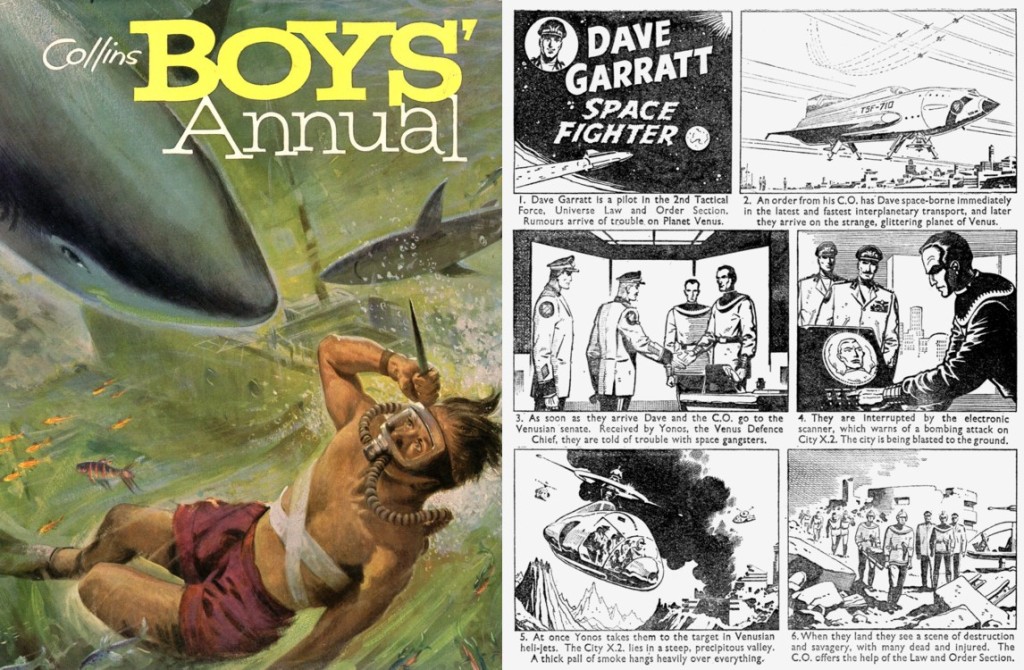
In Dave Garratt: Space Fighter he returns to Venus where space gangsters are attacking Venusian cities. Garratt and three other pilots use jet fighters to attack and destroy the gangsters heavily defended hideout.
Frustratingly not all the Collins Boys’ Annuals have printed dates although the British Library lists the first appearance of the title as 1954. Dave Garratt: Champion Of Peace was published in the annual with a copyright date of 1959, Dave Garratt: Space Fighter was published in the annual with a copyright date of 1960, and while the annual Dave Garratt and the Space Pirates is in is undated, based on the binding and cover style, it would appear to predate the 1959 dated annual probably to 1958. It certainly cannot be earlier than 1957 and the reason for that statement will soon become clear. The Space Pirates strip was reprinted, with some basic spot colour, by The Children’s Press (a Collins imprint) in The Giant Book of Amazing Stories a softcover publication which dates to either 1960 or 1961.

With Dan Dare still adventuring in the weekly Eagle at the time, the strips come across as the Collins editor wanting a Dan Dare style strip as part of the contents of the publications. As part of a forthcoming interview with Ian Kennedy in Spaceship Away magazine about his Dan Dare work for new Eagle comic in the 1980s, Duncan Of Jordanstone College of Art And Design lecturer Phillip Vaughan and I took the opportunity to ask Ian about this very early science fiction work of his in the annuals of a book (rather than a comics) publisher.

Casting his mind back over half a century Ian explained that his agent in Dundee at that time, Bill McCail, was instrumental in that connection with Collins, “He did quite a lot of work for them, or at least have artists do a lot of work for them, writers and artists I assume, and it was at that time that he got me these bits and pieces to do.
“I don’t know what triggered it off but I decided I would write the script and if my memory serves me correct Dave Garratt was one of the pilots in the Red Arrows, the original Red Arrows way back in those days when they flew the Folland Gnats and, I’m not absolutely sure, I have an awful funny feeling that this is my “sentimental Kennedy” coming out here, because I think Dave died in an accident and I decided that I would christen the hero of this script Dave Garratt. My memory may be serving me wrongly here but I have a funny feeling that was the reason for naming the hero Dave Garratt.”
Not previously known to have written any of his comics work, when asked about both writing and illustrating the strip Ian told us, “Probably the one and only time! It was a nice departure but it’s always better to leave it to the professional writers, they know what they are doing!”
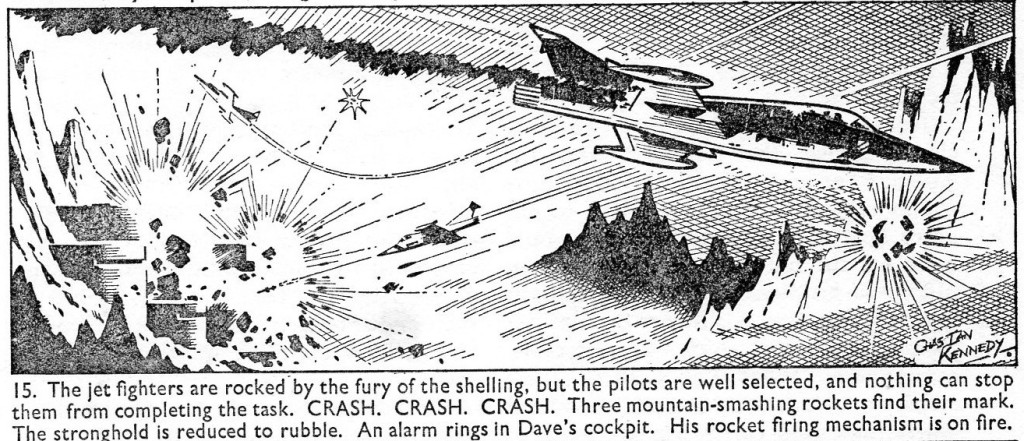
Given that the Red Arrows flew their first display in 1965 and their first fatality was in 1969, the publication dates for the Dave Garratt strips of a decade before that crash seemed much too early. However before the Red Arrows were formed as the definitive RAF aerobatic display team there were a selection of other teams provided in the main by various front-line squadrons. In 1957 111 Squadron based at RAF North Weald in Essex, in addition to their normal day-to-day activities, flew five black Hawker Hunter F6 jet fighters as the Black Arrows.

On 7 June 1957 the team were practising aerobatics over their base for their forthcoming appearance at the Farnsworth air show when two of the Hunters collided. One of them, registration XE621, despite having a damaged wing was able to land at what is now Stansted airport and its pilot survived. However the other Hunter, registration XF525, crashed on the nearby railway line damaging the track and causing a train to de-rail injuring three of its passengers. The 27 year-old pilot of the doomed aircraft did not survive the crash – his name was Flying Officer David C Garratt and he was known to his family as Dave.
Today RAF North Weald is a civilian general aviation airfield with a separate North Weald Airfield Museum, while the railway, which was then the eastern over ground end of the London Underground’s Central Line, is now the Epping Ongar Railway operated by enthusiasts as a heritage line. Both museums are aware of the crash and the airfield museum lists Dave Garratt as the penultimate fatality associated with the base before it was deactivated by the RAF.
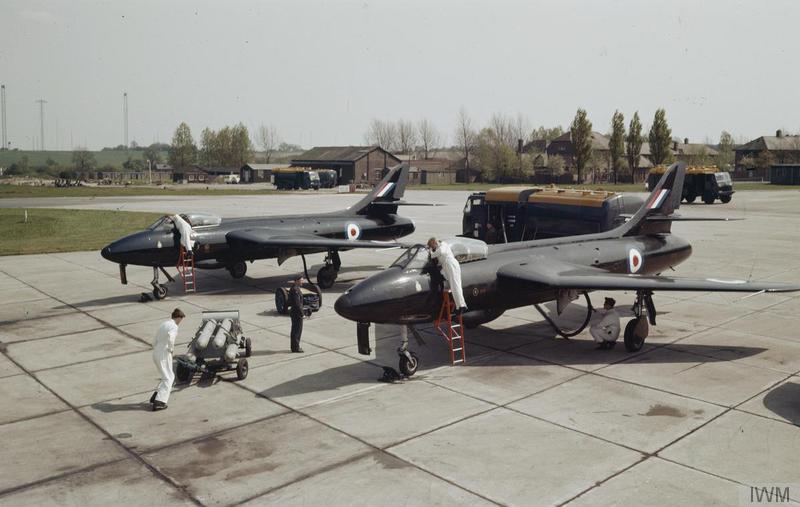
Two Hawker Hunters of No 111 Squadron’s aerobatic display team ‘The Black Arrows’ undergoing servicing at their home station. © Crown copyright: IWM (RAF-T 232) and used under IWM Non Commercial Licence
Given the intervening years, and the fame that the Red Arrows have garnered since their formation, it is more than understandable that Ian Kennedy would have transposed the colours of the two aerobatic teams. The Hunter F6 that Garratt was flying that day in June 1957 was delivered to the RAF less than a year beforehand on 1 October 1956. It appears to have been a 19 Squadron airframe that was on loan to 111 Squadron at the time and so was unlikely to have been painted black.
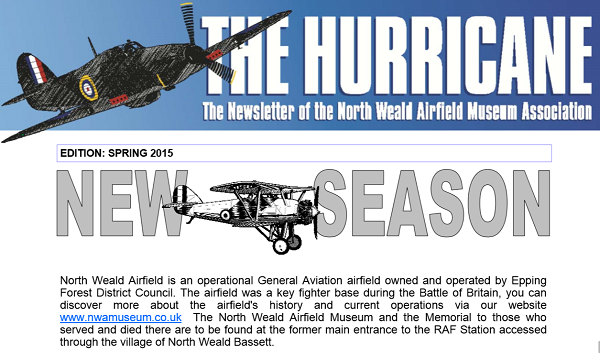
Indeed in a ‘Letter To The Editor’ in the Spring 2015 issue of North Weald Airfield Museum’s newsletter The Hurricane, former RAF Senior Aircraftman (SAC) Roy Bell remembers Dave Garratt’s crash saying, “That afternoon we were eagerly waiting to get away for Whitsun grant. The workshop end doors were wide open as it was a warm day and I was working on a piece of ground equipment, facing the open doors. There was a roar as, I believe, five camouflaged Hunters beat up the runway at low-level. Then there was a bang and a huge ball of flame and black smoke-filled the sky. I think they were flying borrowed aircraft, not the black ones for some reason, having been away from base for a few days on some exercise.”
He goes on, “As to the crash, I believe the aircraft were in echelon and No 4’s wing tip touched No 5’s. The noise of the bang was in my ears for days. Miraculously no one on the ground was injured. Our Sergeant PTI (Physical Training Instructor) whose name I forget was on a tractor mowing the sports field across the Epping Road. He told some of our staff that he ducked and wrapped his arms over his head and heard stuff whistling past him, but was untouched. The Aden gun pack (of the Hunter aircraft) hit the railway line knocking it out of alignment, just before a train was due, but that was stopped.
Flying Officer D C Garratt of the Black Arrows was buried in the military section of the graveyard of the Parish Church of St Andrew near RAF North Weald where he still rests. His family chose the following words to be added to the bottom of his RAF gravestone, “To the perpetual memory of our beloved son Dave”.
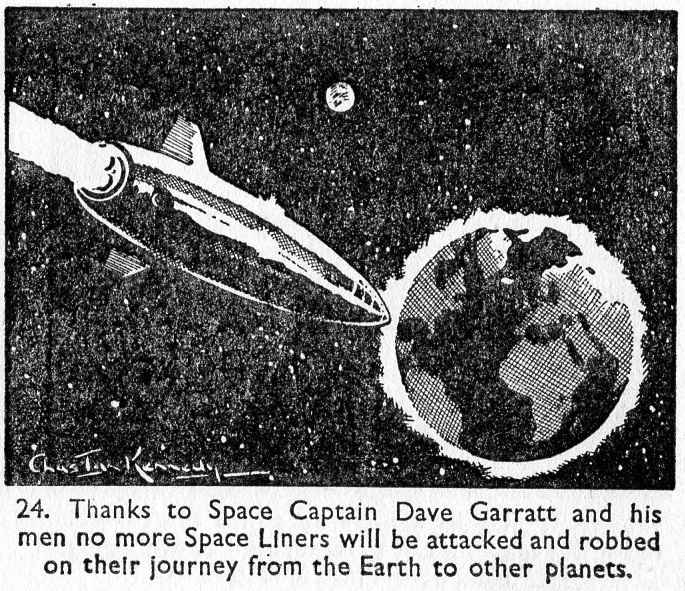
Today, because of Ian Kennedy’s decision back then to honour a fallen pilot by naming his own Space Captain character after him, we continue the memory of Flying Officer Dave Garratt as his parents wanted almost sixty years ago.
UPDATE – 24 February 2019
In response to the original article above, downthetubes.net has received the following letter from Andrew M. Ockenden, one of the RAF ground crew of 111 Squadron’s Black Arrows, who knew and worked with Flying Officer Dave Garratt. We very much appreciate Andrew taking the time to write to us and especially for providing something that we could not locate in 2016, photographs of F/O Dave Garratt. The letter has been lightly edited for length and clarity.
Hi Downthetubes.net,
I have just been reading with great interest the story of the comic book character Dave Garratt (and) I have been very pleased to read the story of his inception as a comic character.
I knew Flying Officer Dave Garratt when I was a member of the ground crew of the Black Arrows aerobatics team from 1956 to 1959. Many times I strapped him into his aircraft before he took off with the team either for a display or in practise. He was a very popular pilot amongst us ‘erks’ and his career in the RAF is also one which would have inspired many young men to pursue their dream to become Fighter pilots. He started his career after training, as a sergeant pilot, and became commissioned a few years later.
I believe I may also have known Roy Bell who is quoted in your article. As you may know those with the name of Bell were always nicknamed Dinger! The Dinger that I knew at North Weald all those years ago was, I believe what we called a safety and surface worker. Some worked on safety equipment whilst others, and I think Roy was one, who painted the aircraft, and certainly their busy time was when the Hunters were painted black (Cellon Docker paint), instead of their previous camouflage paint scheme.
The accident which claimed the life of Dave Garratt was the result of two aircraft touching wings. The aircraft were pulling out of a loop in V formation, and it was the pair on the left of the formation which collided with each other. Dave Garratt’s aircraft was the outermost aircraft at that side, and he had no chance to recover, considering the direction in which they were going towards the main road to Epping from North Weald. It is a miracle that the aircraft did not crash into the hangar nearest to that road, in which case there may well have been many casualties. In those days it was the hangar of ASF (Aircraft Servicing Flight), the hangar in which the aircraft were normally painted with their colour scheme.
The aircraft which collided with Dave’s aircraft went to land at Stanstead. With 3 other members of the ground crew I was sent by Land Rover to Stanstead to examine the aircraft for damage and to bring back the pilot who was in a state of shock. The poor man could hardly speak and never flew again. I later met him when he had become a Wing Commander doing administrative duties.
I was a member of the Guard of Honour at the funeral at the St. Andrew Church in North Weald and with another member, who is a good friend, we visit when we can get together to pay our respects to him. He was a fine young man and I attach a photo of him on one of our squadron parades, I am standing behind him at his left shoulder.
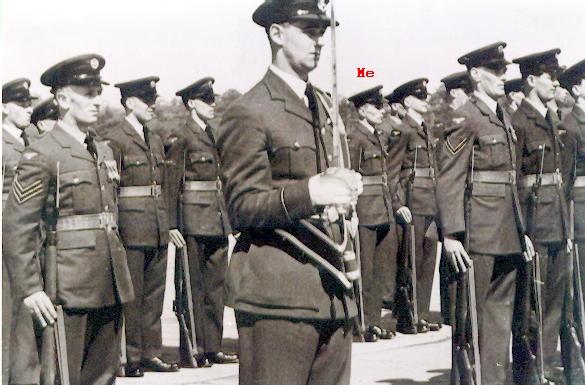
Dave Garratt (with sword) and Andrew M Ockenden highlighted – 111 (F) Sqn Standard Presentation on 30 April 1957
I have hundreds of photos of those happy days and I am pleased to be able to say I am still in contact with some of my fellow ground crew as well as some of the pilots. The Boss in those days at North Weald, Squadron Leader Roger Topp AFC and 2 Bars, is now in his late nineties! I am now 81 years young!
It has been great to read about the inspiration for Dave Garratt and I feel sure he would have been greatly gratified to know that himself.
Yours truly,
Andrew M. Ockenden
The Dave Garratt And The Space Pirates strip is available on ComicBook+ and was sourced from Peter Richardson’s Cloud 109 blog.
The partially coloured Giant Book of Amazing Stories reprint of Dave Garratt And The Space Pirates is on Flickr.
There is more detail on the contents of The Giant Book of Amazing Stories on Steve Holland’s Bear Alley blog.
There is a photograph of F/O Dave Garratt’s gravestone on PaulHP’s Flickr.
There are more details of the Hawker Hunter XF525 crash on the Aviation Safety Network.
There are more details of the North Weald Airfield Museum and the Epping Ongar Railway on the two organisations’ websites.
There are more details of the Parish Church of St Andrew’s graveyard on the Commonwealth War Graves Commission website.
With thanks to Ian Kennedy and Phillip Vaughan.
Information on any other Dave Garratt strips or reprints not mentioned in this article would be gratefully received.
News, reviews, interviews and features for print and on-line: Spaceship Away (since October 2005), Bear Alley (since February 2007), downthetubes (since June 2007), and Eagle Times (since October 2008). Plus DC Thomson’s The Art Of Ian Kennedy, Titan’s Dan Dare and Johnny Red reprints, Ilex’s War Comics: A Graphic History and 500 Essential Graphic Novels, and Print Media’s The Iron Moon and Strip magazine.
Categories: British Comics, Comic Creator Interviews, Creating Comics, downthetubes Comics News, downthetubes News, Features
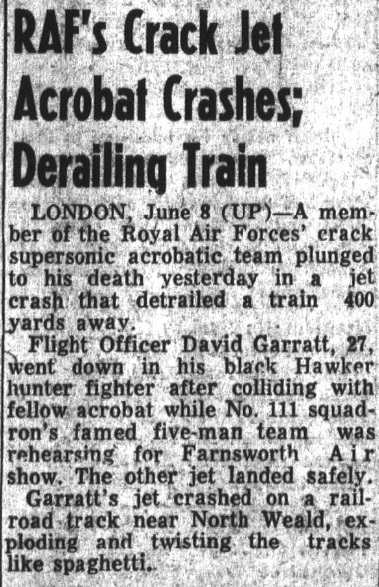
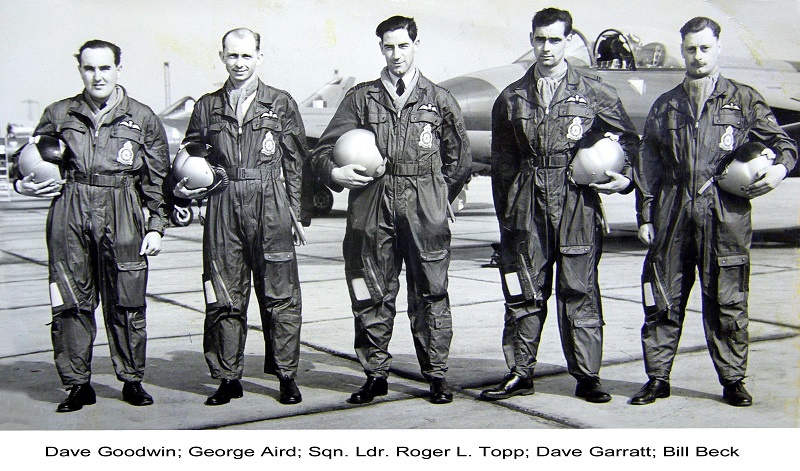
 Crowdfunding Spotlight: Who Killed Nessie? A Quick Chat with Paul Cornell & Rachael Smith
Crowdfunding Spotlight: Who Killed Nessie? A Quick Chat with Paul Cornell & Rachael Smith  Catching up with the Comics Laureate! An interview with Bobby Joseph
Catching up with the Comics Laureate! An interview with Bobby Joseph  New Carol Day newspaper strip collection cut-off date for pre-orders fast approaches
New Carol Day newspaper strip collection cut-off date for pre-orders fast approaches  Piston Pumping! Rob Williams and Pye Parr’s Petrol Head – Exclusive Interview
Piston Pumping! Rob Williams and Pye Parr’s Petrol Head – Exclusive Interview
It’s very rare that you can trace a link in a comic story to a single event that predicated it’s inclusion in the story. Fantastic piece of detective work on this and I commend all of those involved, and even though I have and knew of those Collins annuals with Ian’s artwork in I assumed it was common knowledge as they aren’t particularly rare. This reveal, predicated by the hard work that was put into it takes these slightly obscure stories by Ian, especially as he wrote them as well, to a new level.